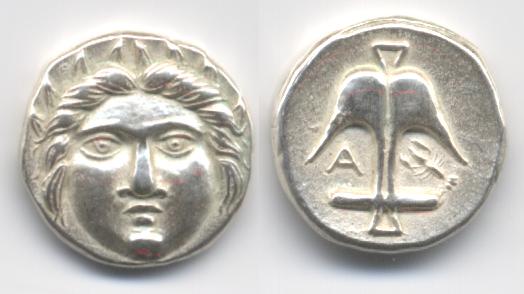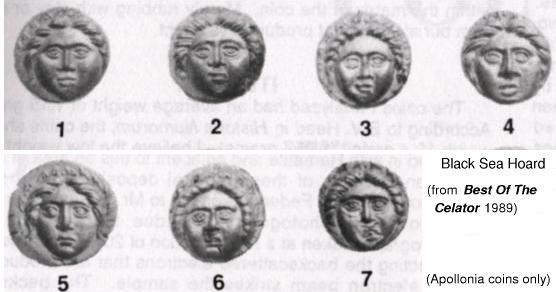
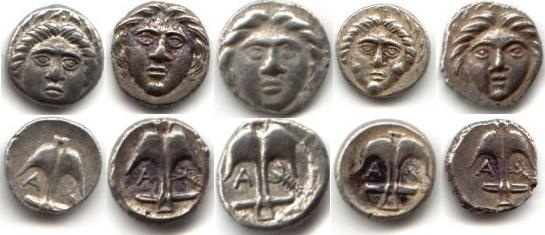
In 1988 a Bulgarian lifeguard discovered a hoard of 150 diobols of Mesembria and Apollonia types. He gave a few to a German tourist to sell in the West. A German dealer bought them for DM 50 (about US $25) each and offered to buy the rest at the same price. The lifeguard smuggled most of the rest of the diobols into Germany but only received DM 30 per coin.
The lifeguard brought his few remaining coins to a coin show in Bulgaria and discovered that he could sell them for DM 40-50. The lifeguard became angry with the German dealer. A Bulgarian die engraver heard the story and offered a way for the lifeguard to get even with the dealer. The die engraver produced more than 15 false dies of the same types and struck 1000 fakes in the ancient way with hot flan and hammer.
The lifeguard bought the fakes for DM 5000 and buried them under water in the Black Sea for a few weeks. The German tourist smuggled the coins out of Bulgaria. The dealer, who had sold the genuine coins for DM 60-150, bought the entire new "hoard" at the low price.
This picture of the Apollonia examples was taken from Kerry Wetterstrom's article which first appeared The Celator magazine. (The Celator did not show the reverses of these early examples of the type. They can be seen on Wayne Sayle's forgery database.)

Coins of the type pictured above were aquired by Heritage Rare Coin Galleries. Laboratory tests seemed to show the coins were authentic. Others doubted the coins. Opinions raged on both sides. For information on the hoard and the tests see Classical Deception by Wayne Sayles. Sayle's book does not include the lifeguard story, which I received from a Bulgarian correspondent. Classical Deception mentions (page 94) that "a museum in Bulgaria" apparently accessioned Mesembrian diobols in 1986, die-matched to the fakes—two years before the lifeguard's story.
The die engraver's dies were sold. A Bulgarian correspondent estimated that 3000-6000 more false diobols have been made from these dies, but pressed hydraulically on cold flans and thus less deceptive than the first batch. More dies were made, and existing dies recut. Dealer Frank Kovacs bought copies as replicas at the Bulgarian National Museum in Sofia, although the museum denied it.
Here are four more fakes, offered as "Black Sea Hoard" counterfeits on eBay in 2002. That's probably the wrong name. It's preferred to use the name only for the hot hammered 1000 fakes. However, some folks use that name for all fakes, and a few use that name for the original 150 genuine ancient coins found by the lifeguard. The first coin, 'a', is a close match for a coin on Wayne Sayle's forgery database described as good silver forgeries.
The second diobol, 'b', seems stylistically similar to two counterfeit diobols on display at AncientCoinArt.com's Gallery of Fakes:
The third and fourth coins seem to be the same image, one with laurel leaves and one without. This kind of change implies the dies were modified, or that hubs were used.
When studying these coins it is important to understand the the dies are being modified. Take a look at the primitive coin. Apollo has a bad case of the mumps! His laurel wreath has a primitive style, but if the image is blown up we can see traces of the usual style of laurel below.
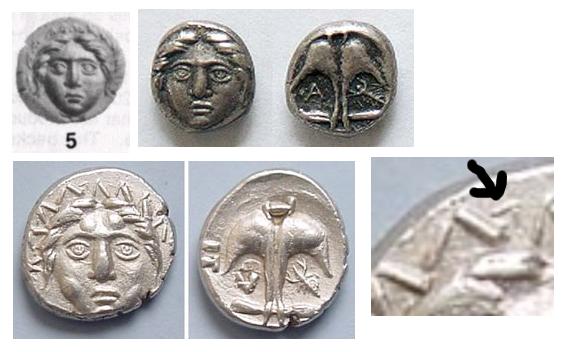
I created this page after finding diobols on the Internet I think look like these known forgeries. I show pictures of questionable coins below. The pictures look fake to me. I am not a professional coin authenticator, have not seen the coins, and this is merely my opinion.
Another non-ancient version of the type is the replica made by the famous Bulgarian die cutter Slavey. I've never seen the Slavey type worn and dirtied up to fool collectors. It's more of a conversation piece. There is a picture of it at the bottom of the page.
This page only discusses diobols. In 1999 a huge hoard of fake Apollonia Pontika drachms appeared, which has been discussed by Reid Goldsborough.
Example 4A Here is a better picture from a coin which sold on eBay in 2002 without anyone noticing. I believe it matches image Celator #4.
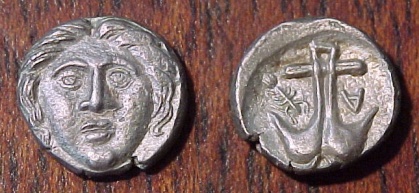
Example 7A An example of #7? This was sold at auction in 1992. I found it in an old catalog. This one seems in better style than the other fakes, and could perhaps be the real prototype of the series? (or not?)

Example 5A Here is a higher resolution image of an example of #5. Notice how the hair on the right side is mushed.
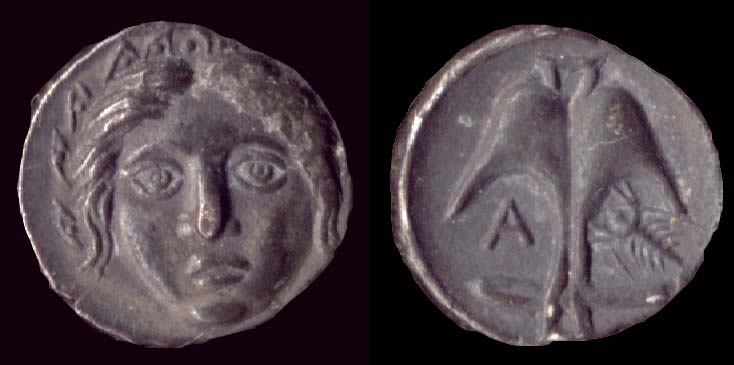
Example 5B Here is another coin which might be #5, from eBay a few years ago. The nose is fatter, though, and the hair doesn't hang down on the left. (Compare to the coin below, which has the same nose but the hair is back?!?)

Example 5-Alt-A This coin looks a great deal like #5. I can't tell from the picture if it is of the same die as #5. The seller agreed it was a likely forgery but insisted it wasn't Black Sea Hoard. The A has the inverse alignment of all published Apollonia coins. I'm 99% sure it's a fake, either from the Black Sea dies or a fake-of-a-fake. (There is always a slight chance this coin is legit and the Black Sea forger used this as a model.) This coin sold on eBay in 2000.

Example 6A The coin, #6?, came from the same source as 5B:

Example 3A 3A resembles #3. It was sold on eBay in Nov '02. I emailed the seller, pointing out the similarity, but the seller did not see a resemblance.
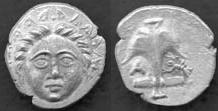
Example bA. The following coin, from the same eBay source as 5B and 6A, greatly resembles 'b' and '2478' in style.
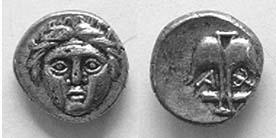
A replica diobol reputed to have been done by the infamous Slavey Petrov:
